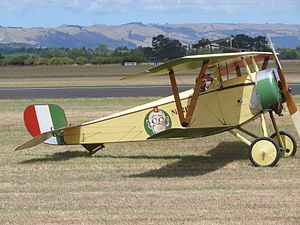The Nieuport 11 (orNieuport XI C.1 in contemporary sources), nicknamed the Bébé, is a French World War I single seat sesquiplane fighter aircraft, designed by Gustave Delage.[1] It was the primary aircraft that ended the Fokker Scourge in 1916.[2] The type saw service with several of France's allies, and gave rise to the series of "vee-strut" Nieuport fighters that remained in service (latterly as trainers) into the 1920s.
| Nieuport 11 | |
|---|---|

| |
| Replica Nieuport 11 in Italian markings | |
| Role | Fighter |
| Manufacturer | Nieuport |
| Designer | Gustave Delage |
| Introduction | 5 January 1916 |
| Status | retired |
| Primary users | Aéronautique Militaire (France) Corpo Aeronautico Militare (Italy), Imperial Russian Air Service |
| Variants | Nieuport 16 |
The Nieuport 11 was a newer, much smaller aircraft based on the general configuration of the Nieuport 10, but designed specifically as a single-seat fighter. Like the "10", the "11" was a sesquiplane, a biplane with a full-sized top wing with two spars, and a lower wing of much narrower chord and a single spar. Interplane struts in the form of a "Vee" joined the upper and lower wings. The sesquiplane layout reduced drag and improved the rate of climb, as well as offering a better view from the cockpit than either biplane or monoplane, while being substantially stronger than contemporary monoplanes. The narrow lower wing could experience aeroelastic flutter, but at air speeds beyond which the Nieuport 11 was capable, and would only become an occasional problem on later much higher powered developments, as well as the German Albatros D.III.[3] Nieuport 11s were supplied to the French Aéronautique Militaire, the British Royal Naval Air Service, the Imperial Russian Air Service, the Belgian Air Force, and Italian Corpo Aeronautico Militare. 646 Nieuport 11s were produced by the Italian Macchi company under licence.[3] After Romania suffered military setbacks, one Nieuport 11, and several Nieuport 12s were transferred from RNAS No.2 Wing as part of the Romanian Flight mission.[4] Additional airplanes received were assembled at Rezerva generală a aviației, however the exact number of Nieuport 11s delivered is unknown.[5]
In 1916 an improved version appeared as the Nieuport 16, which was a strengthened Nieuport 11 airframe powered by a 110 hp (82 kW) Le Rhône 9J rotary engine.[2] Visible differences included a larger aperture in front of the "horse shoe" cowling and a headrest for the pilot.[3] The Nieuport 16 was an interim type pending the delivery of the slightly larger Nieuport 17 C.1 whose design was begun in parallel with the 16, and remedied the 16's balance problems, as well as further improving performance.[6]
The Nieuport 11 reached the French front in January 1916, and 90 were in service within the month.
This small sesquiplane outclassed the Fokker Eindecker in every respect, including speed, climb rate and maneuverability. It featured ailerons for lateral control rather than the Fokker's wing warping, giving lighter, quicker roll response, and its elevator was attached to a conventional tail plane which provided better pitch control as opposed to the all-moving, balanced "Morane type" elevators of the Fokker.
The Fokker's sole remaining advantage was its synchronized machine gun, which fired forward through the arc of its propeller. At the time, the Allies lacked a similar system, and the Nieuport 11's Lewis machine gun[note 1] was mounted to fire over the propeller, allowing uninterrupted forward fire. The Lewis was not synchronizable, due to its open bolt firing cycle design which resulted in an unpredictable rate of fire.[citation needed] Clearing gun jams and replacing ammunition drums in flight were challenging though, and the drums limited ammunition supply.
During the course of the Battle of Verdun in February 1916, the combination of the Nieuport 11s technical advantages and its concentration in dedicated fighter units allowed the French to establish air superiority, ending the so-called "Fokker Scourge" and forced radical changes in German tactics. The impact of the Nieuport was so dramatic that in mid to late 1916 several captured examples were repaired, rearmed with a synchronised "Spandau" gun, and flown at the front.[7] Others were supplied by Idflieg to several manufacturers with the request that copies be built, and this had considerable influence on German fighter design.
Some Nieuport 11s and 16s were fitted to fire Le Prieur rockets from the struts for attacks on observation balloons and airships.[3]
By March 1916 the Bébé was being replaced by both the Nieuport 16 and the much improved Nieuport 17, although Italian-built examples remained in first line service longer, as did Russian examples. Thereafter the Nieuport 11s continued to be used as trainers.[3]
Data from Davilla, 1997, pp.360 & 364, and Pommier, 2002, p.169
General characteristics
Performance
Armament
Related development
Aircraft of comparable role, configuration, and era
Related lists